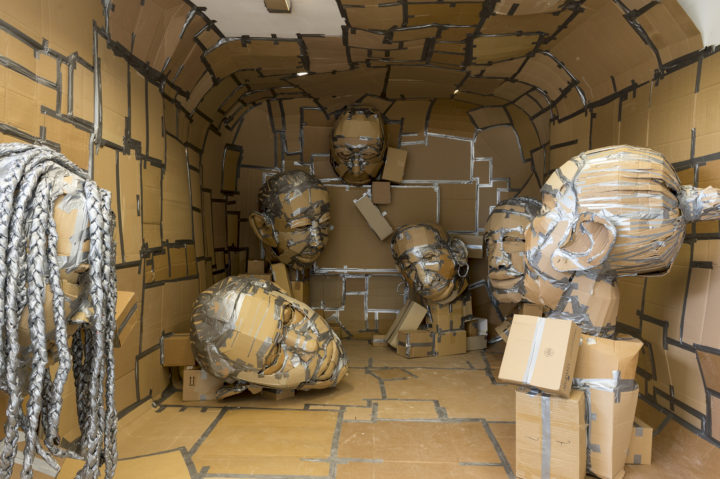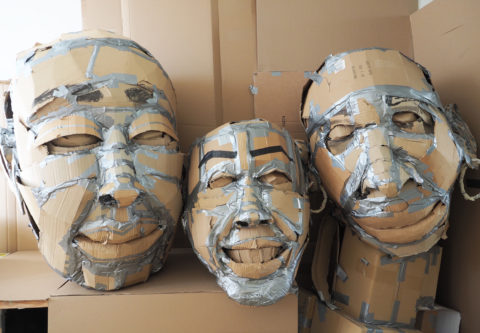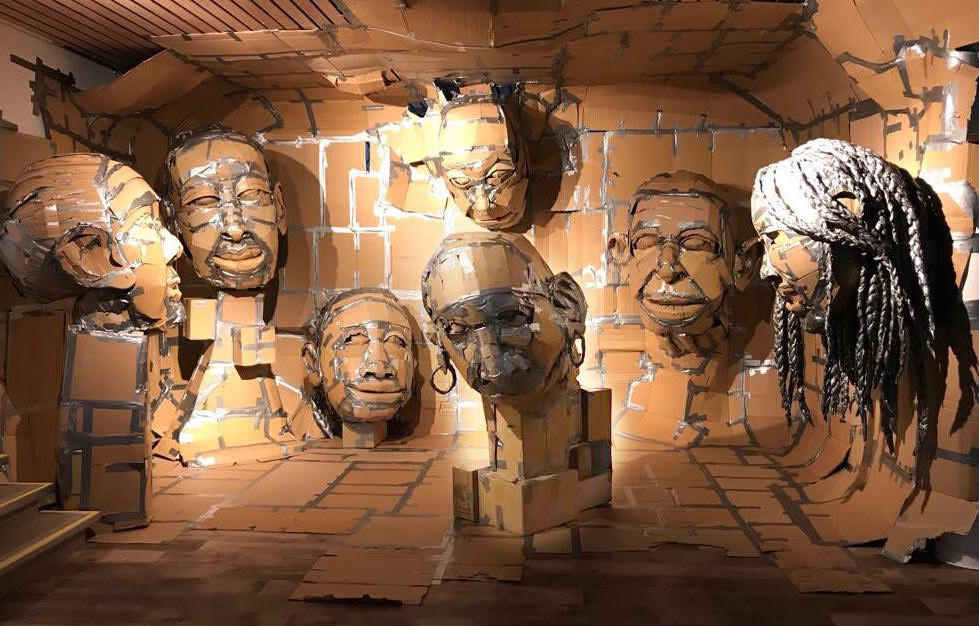
My aim is to bring more young people on Curacao in contact with art. I have had so many friends in high school who ended up in crime. I want to show them that there are other ways. Just as people in the Netherlands should be more aware of the past and how that past shaped the present, people on Curacao should be more aware of the fact that the future is in their own hands. Instead of fighting each other, we should be fighting together for a better world.
Manon Braat in conversation with Quentley Barbara from Curacao
Portraits in Cardboard
Quentley Barbara
Quentley Barbara (Curacao, 1993) graduated last summer and won the Jan Roëde Prize 2018, an incentive prize for recently graduated artists from the Royal Academy of Visual Arts in The Hague, the Netherlands. His graduation work, The Foreigners, consisted of large scale sculptural portraits made out of cardboard and gaffer tape. The jury report spoke of great craftsmanship, but above all of a completely original and contemporary artistic vision on the classic theme of the family portrait. Currently, Barbara participates in The bricks that build a home, a group exhibition about what it means to feel at home, in the recently opened Migration Museum in The Hague. On show is an expansion of his work The Foreigners.

The Foreigners, 2018, photo KABK
You told me everybody in your family is and always has been an electrical engineer. When did you realize that you did not want to become an electrical engineer but an artist?
As a child, I was always drawing, mostly caricatures. Since I was thirteen I had been following an art orientation course on Curacao, at the Instituto Buena Bista (IBB). High school on Curacao starts at half past seven in the morning and ends at two o’clock in the afternoon. After school finished I went to IBB, every day of the week. I did that for almost seven years. These were very busy years. At first I also played soccer but I had to say goodbye to the team because I didn’t have the time for it anymore.
When I was sixteen, I realized that I wanted to become an artist. My parents initially didn’t support my choice. They would have preferred a job with financial security for me. They didn’t believe I could get anywhere in life with drawing and painting. Only my grandfather encouraged me to follow my dream.
What was the orientation course at the Instituto Buena Bista like?
The institution was founded by Tirzo Martha, David Bade and Nancy Hoffmann. It is a preparatory course for young people who want to continue studying art abroad. There are about 20 people at the institution and it is getting bigger every year. They prepare people to go to art academy but also to film academy, or to study graphic design etc. At the visual arts course, you get to experiment with all sorts of materials, do model drawing, painting, sculpting, and they also teach art history. There is a focus on European art but we also learned about art from the Caribbean and Latin America.

The Foreigners, 2018 (detail), photo KABK
Why did you choose the Royal Academy of Visual Art at The Hague (KABK)?
On Curacao there is no art academy and I heard that the KABK was one of the best academies in the Netherlands. The orientation course at the IBB gives you a great chance to be accepted at an art academy in the Netherlands. They also help you with the admission procedure, how to make a portfolio etc.
What was it like to move to Holland and start your studies at the KABK?
From the very first start it has been very educational but also very intense. I suddenly lived in a whole new country with a different culture. I was only 18 years old and not very mature or independent. That made it tough in the beginning.
Can you tell us something about the similarities and differences between IBB and KABK?
The courses are very similar. At both places you are trained by professional artists. At IBB however, because there are residencies for international artists, you are trained by both local and international artists. That was very instructive because it made me look at art from very different perspectives and in the context of different cultures. This is much less the case at the KABK. During my studies at KABK, I had 4 permanent teachers and a few occasional guest teachers. Another difference is the social involvement, which was much bigger at IBB. We were more closely connected to society because we, for example, worked together with a psychiatric hospital. I would have liked it if the KABK also cooperated with schools or hospitals or other public institutions in The Hague. What I really liked about studying in the Netherlands was that I was able to actually see many artworks in Dutch museums that I only knew from books in Curacao.

The Foreigners, 2018 (detail), photo KABK
You are now participating in an exhibition in the newly opened Migration Museum in The Hague. What are you showing and how did the work come about?
I show an expansion of my graduation work The Foreigners. I already had portraits of my father, mother, brothers and sister, my grandmother and my deceased grandfather. For this installation I added new portraits of my uncle and my aunt.
I started making sculptures of my friends on Curacao. I find it important to make work that is very close to me, it is like a biography. After my friends, I wanted to portray my family members. I did not have a good relationship with my mother and I have always felt I was the black sheep of the family. My mother had to raise three children on her own and I always had the impression that I received less attention from her than my brothers did. At the same time, my mother has a very large share in shaping my personality and I am sure that I hadn’t been where I am today if it hadn’t been for her. That’s why I wanted to portray and honor her, just like my other family members. Because I am so far away from home, I am also a bit homesick. I need to be in contact with them and using them in my work is a way of doing that.
Luckily they all love to be part of my art. My father saw the installation I recently showed at Museum Belvedere in Heerenveen and he was deeply impressed by how recognizable his portrait was. Everyone who knows him immediately can tell that it’s him.
My family is also a bit more involved now. When I went to IBB on Curacao, my mother did not know what I was doing there; she didn’t ask me anything about it. Nor did my father. The only person with whom I could share what I was doing was my grandfather.
By the time I had to graduate, I was already very fascinated by cardboard, and I wanted to give it a value that it usually doesn’t have in the Netherlands. This was mainly because I saw so much cardboard on the streets in The Hague and I was very surprised that people throw away so much stuff that is still perfectly fine. Every Tuesday cardboard is taken out onto the streets by residents to be picked up by the municipality. That’s when I get up early and score big time!
I use photographs of my family members and model the cardboard with scissors and tape as much as possible to their resemblance while at the same time I am being guided by the emotions I feel towards every individual family member and I try to visualize these emotions in the portraits.
Why did you make the portraits on such a large scale?
I want them to be monumental because they are so important to me. The size of the head shows the importance of that person in my life. They do vary a bit, haha.
The new Migration Museum in The Hague tells and visualizes migration histories of the various migrant groups in the Netherlands in general and in The Hague in particular, while at the same time emphasizing the richness of the city’s current cultural diversity. What are your thoughts on the museum and exhibiting there?
I think a migration museum can contribute to the cultural knowledge of residents of The Hague, and of the Netherlands in general. It makes sense to get to know migrants’ histories better, to learn more about the cultures people come from so that we get to know each other better. I like to exhibit here and contribute to that goal.
You can look at my work in a political context, because I am someone from Curacao who came to study in the Netherlands as a result of the colonial history that connects Curacao to the Netherlands. But that is not my intention per se. To me, my work is most of all very personal. At the same time, as someone who was not born in the Netherlands, I am a part of the Dutch society, and that should be recognized and understood.
What is your impression about the historical awareness of people of your age in The Hague, about their knowledge of the history of colonialism and slavery in the Netherlands?
When I got here and started to hang out with some white fellow students, they turned out to know nothing about Curacao or the history that binds the Netherlands and Curacao. They never learned about the history of colonialism and slavery. I found that rather disappointing. But I have to say that many people are interested in listening to my stories about Curacao.
I have lived here for five years now and I can see things are changing, even though it’s happening slowly. When I first got here, I hardly found museums that dealt with subjects related to colonial history and migration. Now I come across it more often. But at the same time the Black Pete discussion shows that there is a long and tough road to go. I guess if schoolbooks could be rewritten and focus on history from more than only the white, Western perspective; it would be a much faster process.

This installation he shows in the Migration Museum in The Hague
To what extent have you been made aware of the colonial history of the Netherlands and Curacao, in school or by the people around you?
Already at primary we learned about the history of Curacao and the Netherlands and about the other colonial histories of the Netherlands, also with regard to Indonesia and Suriname for example. That is why the Migration Museum has so much significance in my opinion, to make people aware of these histories that connect them to so many people from other parts of the world.
Where do you see yourself in ten years from now?
I think it’s valuable for our island that we can study in the Netherlands. You can learn a lot of things here and use them to invest there. That is what many people from Curacao do and it is also my plan. I want to stay here for a couple of years and gain experience as a professional artist. Maybe I want to do a Masters at a university somewhere or follow a postdoc course at De Ateliers or the Rijksakademie in Amsterdam. But then I definitely want to go back to Curacao.
I hope to be able to teach at the IBB myself one day. Tirzo Martha is a great inspiration for me. Not only because of his art practice, but he has also been a kind of father figure to me during all those years at the IBB. He and David Bade keep in touch with all their students and they are now following me in my development.
My aim is to bring more young people on Curacao in contact with art. I have had so many friends in high school who ended up in crime. I want to show them that there are other ways. Just as people in the Netherlands should be more aware of the past and how that past shaped the present, people on Curacao should be more aware of the fact that the future is in their own hands. Instead of fighting each other, we should be fighting together for a better world.
The exhibition at the Migration Museum is called The bricks that build a home and deals with migration and belonging. What is home to you?
Curacao will always be home to me. But I have become to feel at home in Holland too.
The bricks that build a home. Migration Museum in collaboration with Nest.
Migration Museum The Hague | 7 December 2018 – 20 January 2019
www.migratie-museum.nl
www.nestruimte.nl

THE MIGRATION MUSEUM
Last September the Migration Museum opened in the government capital of the Netherlands, The Hague. It is located in a beautiful building in the city center that was built as a Laborer’s Society in the 19th century. The museum is run by Wim Manuhutu.
The museum presents itself as a new meeting place that makes the heritage of The Hague around migration accessible to a wide audience. The museum collects stories about migration to present them in a contemporary way, with exhibitions, cultural events, debates, lectures and other public activities. Stories about people who came to the Netherlands for various reasons and built up their lives there. Stories that are not commonly known, from people who want to move forward without forgetting their history and origin. They are the Hague residents who have been building present-day The Hague since 1945.
